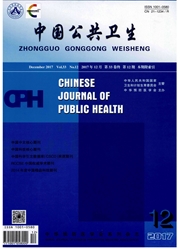

 中文摘要:
中文摘要:
目的探测2005--2012年广西艾滋病(AIDS)时空聚集性,为广西艾滋病病毒(HIV)感染者/AIDS病人针对性防控措施的制定和防控资源的优化配置提供参考依据。方法从县区尺度上,对广西2005--2012年AIDS的新报告率运用空间经验贝叶斯平滑率估计法进行平滑处理;通过泊松模型的时空扫描统计量探测AIDS的时空聚集性;采用地理信息系统(GIS)实现时空聚集区的可视化。结果空间经验贝叶斯平滑估计的新报告率专题图和时空扫描统计量均揭示柳州市城区(城中区、鱼峰区、柳南区、柳北区)、鹿寨县、柳江县、柳城县、贺州市八步区、钦州市灵山县、西南部与越南相邻的龙州县、宁明县、凭祥市、防城港市的港口区、防城区、东兴市、贵港市的港北区、港南区、覃塘区及兴业县等是广西AIDS疫情流行严重地区;2005--2012年,广西HIV/AIDS新报告率存在6个高发的时空聚集区,其中一级时空聚集区以鹿寨县为中心,辖17个县区,始于2011年3月,止于2012年9月(LLR=1886.21,RR=2.97,P=0.000);主要的次级时空聚集区以上思县为中心,辖20个县(市、区),聚集于2010年3月-2011年9月(LLR=944.69,RR=2.00,P=0.000);其次为以贵港市港南区为中心,辖11个县(市、区),聚集于2010年11月-2012年5月次级时空聚集区(LLR=135.02,RR=1.36,P=0.000)。结论时空扫描统计量可以较好地揭示广西AIDS的时空聚集性,相关部门应该加强对AIDS时空高发聚集区的防控工作。
 英文摘要:
英文摘要:
Objective To detect the spatiotemporal cluster of human immunodeficiency virus/acquired immunodefi- ciency syndrome(HIV/AIDS) in Guangxi Zhuang Autonomous Region(Guangxi) from 2005 through 2012. Methods Spatial empirical Bayesian smoothing(SEBS)was used to smooth the notified incidence of HIV/AIDS at county level from 2005 through 2012 in Guangxi. HIV/AIDS spatiotemporal clusters were identified by using spatiotemporal scan sta- tistics and Poisson model and then were visualized via Geographic Information System (GIS). Results The areas with the most serious HIV/AIDS epidemics, including urban area and some counties of Liuzhou and Hezhou city and some counties in southwest region adjacent to Vietnam, were identified with both thematic maps of notified incidence adjusted by SEBS and spatiotemporal scan statistics. There were six spatiotemporal clusters of HIV/AIDS notified incidence in Guangxi from 2005 through 2012. Among the clusters, the first-level cluster areas centered on Luzhai county and covered 17 counties( cities/districts), with the clustering time from November 2010 through September 2012 (log likelihood ratio (LLR) = 1886. 21, relative risk(RR) = 2. 97 ; P = 0. 00 ) ; the main second-level cluster areas centered on Shangsi county, including 20 counties (cities/districts), with the clustering time from March 2010 through September 2011 (LLR = 944. 69, RR = 2. 00; P = 0. 00 ) ; the other cluster areas centered on Gangnan district of Guigang city and covered 11 counties ( cities/districts), with the clustering time from March 2011 through May 2012. Conclusion Spatiotemporal scan sta- tistics could be applied to reveal the spatiotemporal clusters of HIV/AIDS in Guangxi. Health departments should strengthen the prevention and control of HIV/AIDS in the areas with spatiotemporal clustering of the epidemic.
 同期刊论文项目
同期刊论文项目
 同项目期刊论文
同项目期刊论文
 期刊信息
期刊信息
